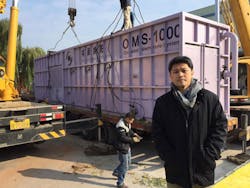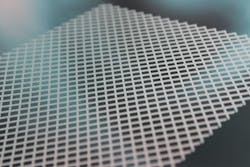3D Printed Water Technology: Entering the Mainstream
In recent years, a number of companies have begun to investigate the potential of using 3D printed parts and components in water treatment and filtration technology. Which water treatment applications has 3D technology been used for to date?
By Andrew Williams.
One of the early front runners in the use of 3D printed technology for water treatment applications is Singapore based company NanoSun, which is currently developing an innovative 3D printed membrane filter.
The filters themselves are created from titanium dioxide, partly because the company claims they are cheaper to produce than plastic, ceramic or stainless steel - but also because, as opposed to other membranes, they do not break down in tough conditions such as extreme heat or cold, or when exposed to the ultraviolet light that is used to disinfect the water. According to NanoSun, other useful features of the material are that it possesses natural anti-bacterial and anti-fouling properties - in essence meaning it is able to clean itself - and also that it allows water to pass through it more easily.
The technology was first pioneered by Professor Darren Sun - an academic at NTU and Visiting Shimizu Professor at Stanford University in the US. He first hit upon the idea as part of his ongoing work to apply advanced materials to the creation of strong and durable membranes. Sun immediately realised that a 3D printed membrane could potentially be of great use to a rapidly urbanising global population in need of reliable and cost-effective wastewater technology.
In recognition of this potential, the company received $2 million in funding two years ago from a combination of private investors and a number of Singapore based public sector organisations, including the Prime Minister’s Office, the Public Utilities Board (PUB) and Nanyang Technological University (NTU) - with the main aim of kick starting the project and developing the NanoSun as a flagship domestic company.
Industrial water potential
According to Ann-Chai Wong, managing director at NanoSun, the membranes are currently being 3D printed at NTU facilities, with concrete plans to step up production “in the near future”. At present, the company’s main focus is on intensifying material science capabilities - and integrating these capabilities with 3D production techniques.
“To attain a reasonable scale, Professor Sun is using state of the art techniques to combine the materials to produce hydrophilic effects,” he says.
Owing to the stability of the membranes - and the fact that they are capable of withstanding a wide range of acidity (pH) levels and temperatures - Wong is confident that there is a large market for the membranes in the industrial wastewater sector. In an effort to exploit this market, he also reveals that an industrial-grade unit that can handle wastewater volumes up to 1000 m3/day has already been deployed in Shandong Province in North China to treat textile wastewater for discharge and recycling applications.
“The next steps would be to scale-up this capability to handle tough waste water, so that this membrane can be immersed in a wider range of applications,” he adds.
In moving towards commercialisation of the membranes, Wong also reveals that he and Sun needed to overcome “numerous system integration issues, while controlling the burn rate” in order to keep pressing ahead.
“At the same time, reaching out to clients who have a need to treat industrial waste water at ever lower prices causes margin compression. The current demand in extremely huge, and the market is very attractive, which explains why we are determined to press on towards growing the company and intensifying the technological developments,” he adds.
Feed spacers
Elsewhere, US industrial behemoth GE announced last November that it had received the backing of the US Department of Energy to further develop an innovative water desalination technology based on miniaturised 3D printed steam turbine turbomachinery, that is used to “compress and stream a mixture of air, salt and water through a hyper-cooling loop that freezes seawater”. By freezing the mixture, the salt is naturally separated into a solid form - leaving just the ice behind, which is melted to produce clean water.
Another US company that has recently moved into the sector is
Minneapolis-based company Conwed, which has uses 3D printing techniques in the creation if its feed spacer technology. As Ivan Soltero, senior strategic marketing manager at Conwed - Global Netting Solutions, explains, the 3D printed spacer technology was developed in order to rapidly test and screen different spacer concepts.
The production process starts when 3D CAD (computer aided design) software is used to draw a small section of a spacer - before the design is sent off to a speciality 3D printing workshop, where the part is printed using a very high resolution type of additive manufacturing. This small section is then sent back to Conwed, where staff can test the printed spacer using various bench top methods they have developed. If the 3D printed coupon performs well, Soltero reveals that the company then moves on to produce it commercially using ‘traditional methods.’
“The 3D printing technology was a key development tool in testing and commercialising a full line of spacers for the brackish and wastewater markets,” he says. “It allowed us to speed up the product development process - as we were able to test ideas without the necessity of running new designs and geometries in our production lines. We focused on testing feed spacer performance in pressure drop, bio fouling and membrane damage scenarios - the three top challenges on every RO system,” he adds.
For Soltero, one of the main challenges the company faced in developing the product related to physically printing a part that was as thin as a traditional feed spacer. In view of the fact that most traditional 3D printers were not able to print a part with the very thin walls required in a spacer, he explains that Conwed had to work closely with a speciality 3D printing shop - and test a variety of different methods of 3D printing - before eventually settling on a suitable candidate.
“The cost can be high, but it is worth it for testing new designs and geometries without incurring full production costs at our plants,” he says.
Although confident that 3D printing will continue to form a key part of the company’s design and production process, Soltero points out that the biggest challenge moving forwards is the ‘restrictive size of the parts.’
“The printing technology is only able to print to a very small coupon, which we can use for some bench top testing. However, for larger scale testing, a newer 3D printing technology would need to be developed in which larger parts may be printed,” he says.
In terms of commercialisation, Soltero reveals that the company’s Alternate Strand Design (ASD) feed spacer also came about as a direct result of 3D printing efforts.
“It is now commercialised in the new Lanxess Lewabrane RO elements. We are also continuing to develop different feed spacers for customised performance targets. Right now we are working on feed spacers that can impact pressure drop, bio fouling and membrane damage,” he adds.
A Home-Printed Revolution?
While progress on using 3D printing techniques for the design, prototyping and production of industrial scale water treatment technologies continues apace, there are also strong indications that the approach could soon be used to create water filters at home - in the process bringing clean water to millions without the need for a central infrastructure.
A growing number of companies are now actively producing 3D printed water filter, including Liquidity Nanotech - which has recently created the innovative Naked Filter. Another very interesting project is the Make Fresh Water project, the brainchild of budding German engineering entrepreneur Cem Schnitzler.
A distinguishing feature of this project is that it provides users with totally free and open source instructions about how to 3D print their own water filter. As Schnitzler explains, the main reason behind the project is to help people that have no access to clean drinking water by enabling them to construct a filtration device using simple and cheap parts.
In basic terms, the Fresh Water Maker works like a cooking pot. To begin with, dirty water is poured into a pot that is then covered with a lid. With the help of the sun, the water is then heated up to a temperature of 85°C inside the pot, through an action closely akin to the greenhouse effect. When the water begins to vaporise, the resultant steam is unable to escape because the pot is closed - causing condensed potable water to slowly build on the surface, where it can be collected for drinking.
Although he has confirmed that the system works, Schnitzler admits that he does not yet have the materials and 3D printers he needs to print prototypes himself. That said, he is convinced that the simplicity of the system could be its main advantage - and he argues that it could be of great use in disaster areas.
“It’s cheap, simple and you can print on demand. For example, in natural disaster situations, an aid organisation can start to print the Water Maker on site - either in trucks or ships - and bring them to the people. With the right 3D printer and the right materials we are only talking about a few pennies per unit - people can withstand a week without food but not without water,” he says. Aware of the need to try out a variety of different materials and manufacturing processes to get the optimal result, Schnitzler is now actively seeking commercial partners. “My goal is not to make money with the water maker, but rather to help people, this is the reason why the printer is open source. Anybody can to start print prototypes. Clean Water is a human right and I hope the water maker brings humanity a step closer to clean water,” he adds.
Andrew Williams is a freelance contributor to WWi magazine.
More Water & WasteWater International Archives Issue Articles


